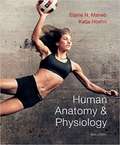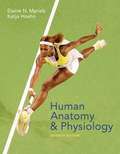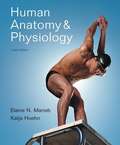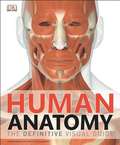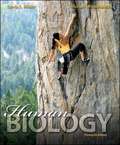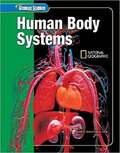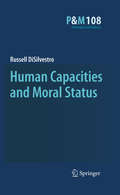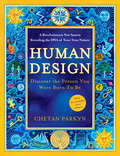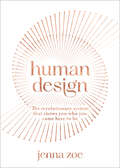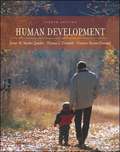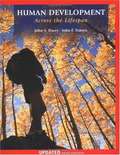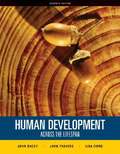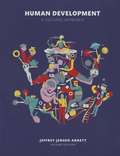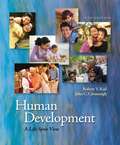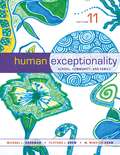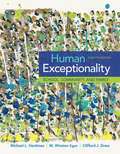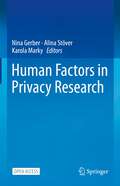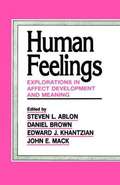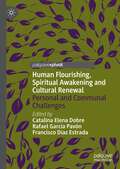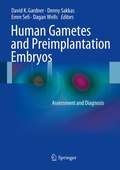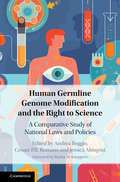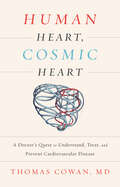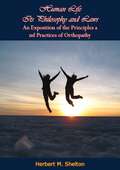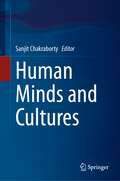- Table View
- List View
Human Anatomy And Physiology
by Elaine N. Marieb Katja N. HoehnNinth Edition of the best-selling Human Anatomy & Physiology, trusted authors Elaine N. Marieb and Katja Hoehn have produced the most accessible, comprehensive, up-to-date and visually stunning anatomy & physiology textbook on the market. Marieb draws on her career as an A&P professor and her experience completing her nursing education; Hoehn relies on her medical education and award-winning classroom instruction—together, they explain anatomy & physiology concepts and processes in a meaningful and memorable way.
Human Anatomy and Physiology (7th Edition)
by Katja Hoehn Elaine Nicpon MariebWith each edition of her top-selling "Human Anatomy & Physiology" text, Elaine N. Marieb draws on her own, unique experience as a full-time A&P professor and part-time nursing student to explain concepts and processes in a meaningful and memorable way. With the "Seventh Edition," Dr. Marieb has teamed up with co-author Katja Hoehn to produce the most exciting edition yet, with beautifully-enhanced muscle illustrations, updated coverage of factual material and topic boxes, new coverage of high-interest topics such as Botox, designer drugs, and cancer treatment, and a comprehensive instructor and student media package. The Human Body: An Orientation, Chemistry Comes Alive, Cells: The Living Units, Tissue: The Living Fabric, The Integumentary System, Bones and Skeletal Tissues, The Skeleton, Joints, Muscles and Muscle Tissue, The Muscular System, Fundamentals of the Nervous System and Nervous Tissue, The Central Nervous System, The Peripheral Nervous System and Reflex Activity, The Autonomic Nervous System, The Special Senses, The Endocrine System, Blood, The Cardiovascular System: The Heart, The Cardiovascular System: Blood Vessels, The Lymphatic System, The Immune System: Innate and Adaptive Body Defensives, The Respiratory System, The Digestive System, Nutrition, Metabolism, and Body Temperature Regulation, The Urinary System, Fluid, Electrolyte, and Acid-Base Balance, The Reproductive System, Pregnancy and Human Development, Heredity For all readers interested in human anatomy & physiology.
Human Anatomy and Physiology (8th edition)
by Elaine N. Marieb Katja HoehnA modern exploration of the human, from its interacting organ systems to the cellular and molecular underpinnings of the functions of life.
Human Anatomy: The Definitive Visual Guide
by Dorling Kindersley Publishing Staff<p>For students of anatomy, biology, and the biomedical sciences; medical professionals; and curious families, DK's Human Anatomy will be a definitive resource. <p>Written by acclaimed anatomist, Dr. Alice Roberts, Human Anatomy is an up-to-the-minute study of the body. Spectacular digital images show the body in incredible, true-to-life detail. Exhaustive annotations provide the names of organs and structures throughout the skeletal, muscular, nervous, cardiovascular, lymphatic, and reproductive systems, while describing their characteristics and functions. <p>This new addition to DK's award-winning catalog of human body titles will help readers better grasp the deep complexities of the human body for research, study, or general reference.</p>
Human Biology (Thirteenth Edition)
by Sylvia S. Mader Michael WindelspechtInstructors consistently ask for a human biology textbook that helps students develop an understanding of the main themes of biology while placing the material in the context of the human body. Mader's Human Biology was developed to fill this void. To accomplish the goal of improving scientific literacy, while establishing a foundation of knowledge in human biology and physiology, Human Biology integrates a tested, traditional learning system with modern digital and pedagogical approaches designed to stimulate and engage today's student. Multimedia Integration: Michael Windelspecht represents the new generation of digital authors. Through the integration of multimedia resources, such as videos, animations and MP3 files, and in the design of a new series of guided tutorials, Dr Windelspecht has worked to bring Dr. Mader's texts to the new generation of digital learners. A veteran of the online, hybrid, and traditional teaching environments, Dr. Windelspecht is well versed in the challenges facing today's students and educators. Dr. Windelspecht guided all aspects of the Connect content accompanying Human Biology. The authors of the text identified several goals that guided them through the revision of Human Biology, Thirteenth Edition: build upon the strengths of the previous editions of the text, enhance the learning process by integrating content that appeals to today's students, deploy new pedagogical elements, including multimedia assets, to increase student interaction with the text, develop a new series of digital assets designed to engage the modern student and provide assessment of learning outcomes.
Human Body Systems: Book D (Glencoe Science)
by McGraw-Hill EducationHuman Body Systems, as a part of the Glencoe Science 15-Book Series, provides students with accurate and comprehensive coverage of the human body and its key organ systems. The strong content coverage integrates a wide range of hands-on experiences, critical-thinking opportunities, and real-world applications. The modular approach allows you to mix and match books to meet your curricula.
Human Brain and Senses Resources: Images, Data, and Readings
by Lawrence Hall of Science StaffTHE FOSS program for Middle School Science
Human Capacities and Moral Status
by Russell DisilvestroMany debates about the moral status of things--for example, debates about the natural rights of human fetuses or nonhuman animals--eventually migrate towards a discussion of the capacities of the things in question--for example, their capacities to feel pain, think, or love. Yet the move towards capacities is often controversial: if a human's capacities are the basis of its moral status, how could a human having lesser capacities than you and I have the same "serious" moral status as you and I? This book answers this question by arguing that if something is human, it has a set of typical human capacities; that if something has a set of typical human capacities, it has serious moral status; and thus all human beings have the same sort of serious moral status as you and I. Beginning from what our common intuitions tell us about situations involving "temporary incapacitation"--where a human organism has, then loses, then regains a certain capacity--this book argues for substantive conclusions regarding human fetuses and embryos, humans in a permanent vegetative state, humans suffering from brain diseases, and humans born with genetic disorders. Since these conclusions must have some impact on our ongoing moral and political debates about the proper treatment of such humans, this book will be useful to professionals and students in philosophy, bioethics, law, medicine, and public policy.
Human Design: Discover the Person You Were Born to Be
by Chetan ParkynGoing beyond horoscopes, Human Design posits that everyone is born with an individuality as unique as a fingerprint. The detailed personality readings Human Design provides empower people to make decisions, choose professions, and create relationships with ease and success because they are no longer struggling against innate strengths and weaknesses. They are instead tapping into their personal power and destiny. Understanding these readings allows people to align their actions with their inherent, truest self. Chetan Parkyn, the foremost international practitioner of Human Design, now offers readers the tools to do their own readings (using a downloadable program), to map the life charts of friends and family, and even to explore the complete life charts of a variety of public figures. Simple, accurate, and wonderfully detailed, Human Design unlocks human potential by answering the age-old question, Who am I?
Human Design: The Revolutionary System That Shows You Who You Came Here to Be
by Jenna ZoeFind guidance, alignment, and purpose with this insightful, practical guide to understanding and interpreting your Human Design chart.World-leading expert Jenna Zoe reveals the power and potential of Human Design in simple steps and shows you how to utilize your results to create an incredible life. Drawing inspiration from many different schools of wisdom, including the chakras, I Ching, astrology, and the Tree of Life, Human Design is a system based on our time and date of birth, illustrated as a unique chart that reveals our opportunities, challenges, personality, strengths, relationships, and much more.Once you have your chart, you can tap into a detailed and unique toolkit to help you unlock your true purpose in this world. You'll discover how to:generate your own chart with an easy-to-follow process find out what your Energy Type is and how you can harness itstop striving to be someone you're not and feel comfortable in your own skinunderstand your intuition, personality, habits, relationships, and moreWhen your chart reveals how to be the real you – the most individual you can be – you'll find that you're able to confidently walk your unique path and live according to your soul's purpose.
Human Development
by James W. Van Der Zanden Corinne Haines Crandell Thomas L. CrandellHuman development
Human Development Across The Lifespan
by John S. Dacey John F. TraversThis chronologically-organized text is briefer than most of the Human Lifespan texts. Its numerous examples drawn from education, nursing, and psychology make the content relevant to students from a variety of majors and backgrounds, while a highly praised study guide integrated into the text promotes and reinforces conceptual understanding. The new edition includes increased material on cognitive development and expanded coverage of culture. .
Human Development Across the Lifespan
by Lisa B. Fiore John S. Dacey John F. TraversAll of the lifespan without all of the bells and whistles. This chronologically-organized text is less expensive and briefer than most Lifespan texts. Its numerous examples drawn from education, nursing, and psychology make the content relevant to students from a variety of majors and backgrounds, while a highly praised study guide integrated into the text promotes and reinforces conceptual understanding.
Human Development: A Cultural Approach
by Jeffrey ArnettHelp students understand how culture impacts development – and why it matters Human Development: A Cultural Approach, Second Edition leads students to examine all stages of development through the engaging lens of culture. The first author to take a wholly cultural approach to human development, Jeffrey Arnett integrates cross-cultural examples throughout the narrative to reveal the impact of cultural factors both in the US and around the world. Arnett’s emphasis on culture fosters a thorough, balanced view of development that prepares students to face challenges in our diverse and globalized world – whether they travel the globe or remain in their hometowns.
Human Development: A Life-Span View
by John Cavanaugh Robert KailBalanced coverage of the entire life span is just one thing that distinguishes HUMAN DEVELOPMENT: A LIFE-SPAN VIEW, 6TH EDITION. With its comprehensive, succinct, and applied coverage, the text has proven its ability to capture students' interest while introducing them to the issues, forces, and outcomes that make us who we are. Robert V. Kail's expertise in childhood and adolescence, combined with John C. Cavanaugh's extensive research in gerontology, result in a book with a rich description of all life-span stages and important topics. A modified chronological approach traces development in sequential order from conception through late life, while also dedicating several chapters to key topical issues. This organization also allows the book to be relatively briefer than other texts a benefit given the enormous amount of information covered in the course.
Human Exceptionality: School, Community and Family, 11th Ed.
by Michael L. Hardman Clifford J. Drew M. Winston EganHUMAN EXCEPTIONALITY is an excellent resource for preparing teacher education candidates and practicing teachers, as well as a range of human services professionals. The book's unique human approach combines the most current research, personal stories about people with exceptionalities, and new and innovative features that create opportunities for readers to better understand and apply the information in each chapter.
Human Exceptionality: School, Community, And Family
by Michael L. Hardman Clifford J. Drew M. Winston EganExpanding on its widely respected and unique focus on the critical role of professionals in education, psychology, counseling, health care, and human services, HUMAN EXCEPTIONALITY: SCHOOL, COMMUNITY, AND FAMILY, 12th Edition, is an evidence-based testament to how cross-professional collaboration enhances the lives of exceptional individuals and their families. This text's unique lifespan approach combines powerful research, evidence-based practices, and inspiring stories, engendering passion and empathy and enhancing the lives of individuals with exceptionalities. Designed to help students experience individuals with disabilities and their families in a personal and intimate fashion, HUMAN EXCEPTIONALITY is an excellent resource for preparing both preservice and practicing teachers, as well as a range of other human services professionals in the fields of psychology, sociology, social work, and the health sciences.
Human Factors in Privacy Research
by Nina Gerber Alina Stöver Karola MarkyThis book covers topics needed to be considered in research around usable privacy. The book starts from a psychological perspective and introduces readers to basic behavioral theories and models that can explain end-user privacy behavior (including the “privacy paradox”) on a theoretical level. Subsequently, an introduction to different study methods (e.g., experiment, survey, interviews, co-creation) used in usable privacy research is given. Based on this, different methodological aspects, such as identifying appropriate questionnaires, and applying User-Centered Design, will be discussed. Finally, the book describes application areas for privacy research such as dark patterns and presents solutions for privacy protection, e.g., regarding consent-giving and PETs. The book aims to bring together the different research approaches to the topic of usable privacy, which often originate from computer science, psychology, and law, and provide a methodologically sound basis for researchers who want to delve deeper into this topic.This is an open access book.
Human Feelings: Explorations in Affect Development and Meaning
by John E. Mack Daniel Brown Steven L. Ablon Edward J. KhantzianDwelling on the importance of emotions in our life, the author through Harvard Affect Study Group has brought together people with different kinds of training to share a passionate interest in the study of affect.
Human Flourishing, Spiritual Awakening and Cultural Renewal: Personal and Communal Challenges
by Francisco Díaz Estrada Catalina Elena Dobre Rafael García PavónThis book seeks to generate a theoretical and a reflective framework to re-connect people with culture and spirituality. It seeks to recreate important links between these domains to provide interpretative, foundational, and ethical perspectives. It is distinctive in that it focusses on the challenges that humanity is facing at a cultural, social, moral, and spiritual level. It provides a philosophical understanding of humanity from a humanistic and multidisciplinary perspective (encompassing ethics, language, art/cinema, political, cultural and gender approaches) and offers a variety of ways of how we can rethink our culture and our society for the future.
Human Gametes and Preimplantation Embryos
by David K. Gardner Emre Seli Denny Sakkas Dagan WellsIn recent years, the advancing science and increasing availability of assisted reproduction have given new hope to infertile couples. However, the use of IVF and ART has also led to marked increases in the number of multiple-infant live births. This poses a public health concern, as these neonates have a higher rate of pre-term delivery, compromising their survival chances and increasing their risk of lifelong disability. By optimizing the selection of gametes and embryos with high probabilities of implantation, it is possible to reduce the number of embryos transferred and, by extension, the number of high-risk multiple gestations, while maintaining or increasing pregnancy rates. Human Gametes and Preimplantation Embryos: Assessment and Diagnosis provides a broad yet concise overview of established and developing methodologies for assessment of gamete and embryo viability in assisted reproduction. This book elucidates the best practices for precisely selecting viable specimens based on morphology and cleavage rate and covers the spectrum of emerging adjunctive technologies for predicting reproductive potential. The authors present their extensive knowledge of "omics" approaches (genomics, transcriptomics, proteomics, and metabolomics), with unbiased delineation of the associated advantages and potential pitfalls. This valuable clinical resource is well suited to infertility specialists, Ob/Gyn physicians, IVF laboratory technicians, and researchers in the fields of embryology and reproductive medicine.
Human Germline Genome Modification and the Right to Science: A Comparative Study of National Laws and Policies
by Romano Jessica Almqvist Andrea Boggio Cesare P. R.The advent of the CRISPR/Cas9 class of genome editing tools is transforming not just science and medicine, but also law. When the genome of germline cells is modified, the modifications could be inherited, with far-reaching effects in time and scale. Legal systems are struggling with keeping up with the CRISPR revolution and both lawyers and scientists are often confused about existing regulations. This book contains an analysis of the national regulatory framework in eighteen selected countries. Written by national legal experts, it includes all major players in bioengineering, plus an analysis of the emerging international standards and a discussion of how international human rights standards should inform national and international regulatory frameworks. The authors propose a set of principles for the regulation of germline engineering, based on international human rights law, that can be the foundation for regulating heritable gene editing both at the level of countries as well as globally.
Human Heart, Cosmic Heart: A Doctor’s Quest to Understand, Treat, and Prevent Cardiovascular Disease
by Thomas Cowan&“This book is life-changing for those trying to understand their own bodies, or those of loved ones, and it&’s truly transformative in the hands of medical professionals, especially young doctors.&”—Foreword ReviewsThomas Cowan was a 20-year-old Duke grad—bright, skeptical, and already disillusioned with industrial capitalism—when he joined the Peace Corps in the mid-1970s for a two-year tour in Swaziland. There, he encountered the work of Rudolf Steiner and Weston A. Price—two men whose ideas would fascinate and challenge him for decades to come.Both drawn to the art of healing and repelled by the way medicine was—and continues to be—practiced in the United States, Cowan returned from Swaziland, went to medical school, and established a practice in New Hampshire and, later, San Francisco. For years, as he raised his three children, suffered the setback of divorce, and struggled with a heart condition, he remained intrigued by the work of Price and Steiner and, in particular, with Steiner&’s provocative claim that the heart is not a pump. Determined to practice medicine in a way that promoted healing rather than compounded ailments, Cowan dedicated himself to understanding whether Steiner&’s claim could possibly be true. And if Steiner was correct, what, then, is the heart? What is its true role in the human body?In this deeply personal, rigorous, and riveting account, Dr. Cowan offers up a daring claim: Not only was Steiner correct that the heart is not a pump, but our understanding of heart disease—with its origins in the blood vessels—is completely wrong. And this gross misunderstanding, with its attendant medications and risky surgeries, is the reason heart disease remains the most common cause of death worldwide.In Human Heart, Cosmic Heart, Dr. Thomas Cowan presents a new way of understanding the body&’s most central organ. He offers a new look at what it means to be human and how we can best care for ourselves—and one another.&“[This book] deserves to be in everyone&’s library. . . . It&’s loaded with great information, and it can save your life or the life of someone you love.&”—Dr. Joseph Mercola
Human Life Its Philosophy and Laws: An Exposition of the Principles and Practices of Orthopathy
by Herbert M. SheltonThis book holds a unique place in the history of natural hygiene. It is a book for all times, all seasons, and all people. It was the first book to give detailed historical and practical credit to most all of the brilliant pioneers who were responsible for establishing the foundations for orthopathy. "Orthopathy" also called "Natural Hygiene," is an alternative medical philosophy derived from naturopathy. It advocates a vegetarian, raw food diet with periods of intermittent fasting. Contents: Health and Its Conditions and Requirements; The Laws of Life; Living Matter Cures Itself; Is Disease Friend or Foe; Early Orthopathic Ideas of Disease; Acute Disease a Curative Process; Self-Limited Disease; The Rational of Inflammation and Fever; Physiological Compensation; Acute Disease not a Radical Cure; Unity of Disease and Symptoms; Causes of Disease; Germs; Perversions; Feeding; Fasting; Sunshine and Sun-Baths; Physical Exercise; Hygiene of Health; Care of Wounds; Place of Art; Passing of the Plagues; Suppression of Disease and its Results.-Print ed.
Human Minds and Cultures
by Sanjit ChakrabortyThis book puts forward a harmonious analysis of similarities and differences between two concepts—human minds and cultures—and strives for a multicultural spectrum of philosophical explorations that could assist them in pondering the striking pursuit of envisaging human minds and cultures as an essential appraisal of philosophy and the social sciences. The book hinges on a theoretical understanding of the indispensable liaison between the dichotomy of minds and objectivity residing in semantic-ontological conjectures. The ethnographic sense of cultures confines the scope of cultural scientism, an evolutionary paradigm on the functionalist turn, where one could enthral the cultural phenomenon from the contentment of the conflict of scientific quandaries. Hence, cultural relativism concedes that cultures have some descriptive contents, like customs, beliefs, moral codes, other minds, etc., that are followed by an individual or a group of people. However, the notion of societalsemiotics embarks on the ‘semiotic conception of culture’ that deploys modernity and values centred on ethical conjectures. Human Minds and Cultures conspicuously attune the cultural edifice of moral minds and cope with the enduring prospects of ethics, genders, laws, and socio-political affairs. Essential reading for anyone with a sparkling interest in human minds and cultures.
